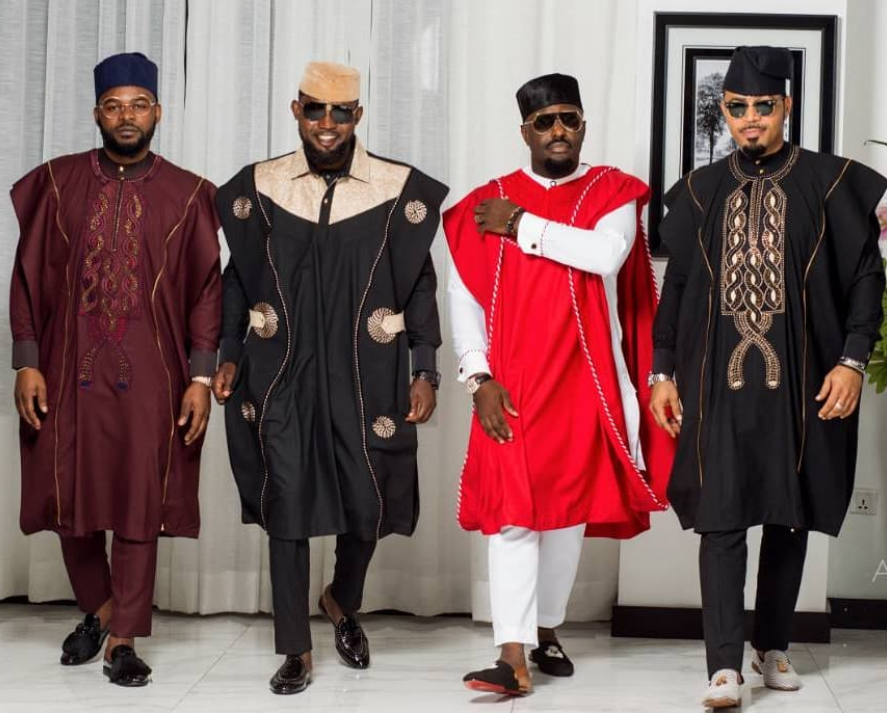
The Agbada, a majestic traditional attire worn across West Africa, is not merely an outfit but a symbol of heritage, identity, and style.
While its essence remains consistent, the Agbada undergoes fascinating transformations as it travels across different regions, each infusing its own unique flair and cultural significance.
Lets delve into the diverse regional variations of the Agbada, exploring how geography, history, and local customs shape its distinct manifestations.
Northern Nigeria:
Regal Elegance In the northern regions of Nigeria, the Agbada takes on a regal and majestic aura, reflecting the grandeur of the Hausa and Fulani cultures. Here, the Agbada is characterized by its voluminous, flowing robes, often adorned with intricate embroidery and embellishments.
The fabric choices lean towards luxurious materials like brocade, damask, or silk, adding to the outfit’s appearance.
This variation of the Agbada is typically worn by nobility and dignitaries during special occasions such as weddings, festivals, and royal ceremonies. The northern Agbada exudes an air of sophistication and prestige, embodying the rich cultural heritage of the region.
Yoruba Land:
In Yoruba-speaking regions, particularly in Nigeria and Benin, the Agbada reflects the vibrant and colorful traditions of the people. Here, bold and bright hues dominate the fabric choices, with intricate patterns and motifs adorning the outfit.
The Yoruba Agbada is often accompanied by matching accessories such as hats (fila) and shoes, creating a coordinated ensemble known as “Aso-ebi.” Each color and pattern holds symbolic significance, conveying messages of joy, prosperity, or cultural identity.
Whether worn during festive celebrations like weddings or cultural ceremonies such as the annual Olojo festival, the Yoruba Agbada is a visual feast that celebrates the rich heritage of the Yoruba people.
Ghanaian Influence:
Elegant Simplicity In Ghana, the Agbada takes on a more understated yet equally elegant form. Known locally as “Batakari” or “Babban Riga,” the Ghanaian Agbada is characterized by its simplicity and versatility. The outfit is often made from handwoven cotton or linen fabrics, reflecting the country’s rich textile traditions. While the silhouette remains similar to its counterparts in Nigeria, the Ghanaian Agbada is distinguished by its earthy tones and minimalistic embellishments. It is commonly worn for formal occasions such as traditional weddings, enstoolment ceremonies, and state functions, accompanying a sense of dignity and pride in Ghanaian culture.
Cross-Cultural Influences: Fusion of Styles Beyond its traditional strongholds, the Agbada has also influenced fashion trends across the globe, thanks to its timeless appeal and versatility. In recent years, designers and fashion enthusiasts have embraced the Agbada, incorporating elements of its design into contemporary clothing styles. From runway showcases to red carpet events, the Agbada has made its mark on the global fashion scene, showcasing the richness and diversity of African heritage.
The Yoruba Agbada: Casual and Ceremonial Styles
The Yoruba Agbada has a long history dating back to the 15th century when it was worn by Yoruba rulers and chiefs. It was a symbol of power and authority and was only worn by the elite class. Over time, the Agbada became more accessible to the masses and was worn by people of all social classes. Today, it is a popular attire for weddings, funerals, and other traditional events.
At Fitted, the Agbada comes in different styles and designs, but there are two main types – the casual and ceremonial styles. The casual Agbada is usually made from lighter fabrics such as cotton or linen and is worn for everyday events. It is less elaborate than the ceremonial Agbada and is often worn without the cap.
The ceremonial Agbada is the more elaborate of the two and is made from richer fabrics such as brocade or silk. It is heavily embroidered with intricate designs that are symbolic of the occasion. The cap is an essential part of the ceremonial Agbada, and it is also heavily embroidered to match the robe.
Fashion shoppers looking to add the Yoruba Agbada to their collection should consider their style and the occasion they intend to wear it for. The casual Agbada is a great option for those who want to wear it for everyday events, while the ceremonial Agbada is perfect for traditional events such as weddings, funerals, and other cultural ceremonies.
When choosing an Agbada, it is essential to consider the fabric, design, and fit. The fabric should be of high quality and comfortable to wear, while the design should be intricate and symbolic of the occasion. The fit should also be comfortable and not too tight, as the Agbada is meant to be loose-fitting and flowing.
The Agbada is more than just an outfit; it is a testament to the diversity and richness of West African culture. From the regal elegance of northern Nigeria to the colorful heritage of Yoruba land and the understated simplicity of Ghana, each regional variation of the Agbada tells a unique story. As the outfit continues to evolve and transcend boundaries, it remains a powerful symbol of identity, pride, and tradition for generations to come.

